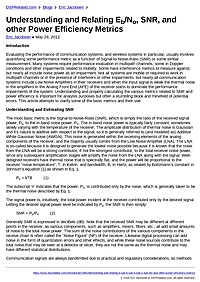
Understanding and Relating Eb/No, SNR, and other Power Efficiency Metrics
Introduction Evaluating the performance of communication systems, and wireless systems in particular, usually involves quantifying some performance metric as a function of Signal-to-Noise-Ratio (SNR) or some similar measurement. Many systems...

Python scipy.signal IIR Filter Design
Introduction The following is an introduction on how to design an infinite impulse response (IIR) filters using the Python scipy.signal package. This post, mainly, covers how to use the scipy.signal package and is not a thorough...
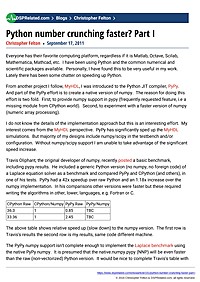
Python number crunching faster? Part I
Everyone has their favorite computing platform, regardless if it is Matlab, Octave, Scilab, Mathematica, Mathcad, etc. I have been using Python and the common numerical and scientific packages available. Personally, I have found this...
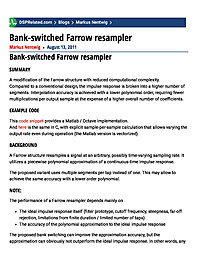
Bank-switched Farrow resampler
Bank-switched Farrow resampler Summary A modification of the Farrow structure with reduced computational complexity.Compared to a conventional design, the impulse response is broken into a higher number of segments. Interpolation accuracy is...
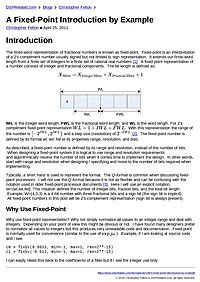
A Fixed-Point Introduction by Example
Introduction The finite-word representation of fractional numbers is known as fixed-point. Fixed-point is an interpretation of a 2's compliment number usually signed but not limited to sign representation. It...
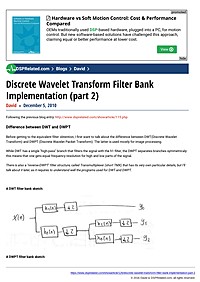
Discrete Wavelet Transform Filter Bank Implementation (part 2)
Following the previous blog entry: http://www.dsprelated.com/showarticle/115.php Difference between DWT and DWPT Before getting to the equivalent filter obtention, I first want to talk about the difference between DWT(Discrete Wavelet...
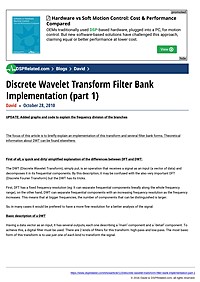
Discrete Wavelet Transform Filter Bank Implementation (part 1)
UPDATE: Added graphs and code to explain the frequency division of the branches The focus of this article is to briefly explain an implementation of this transform and several filter bank forms. Theoretical information about DWT can be found...
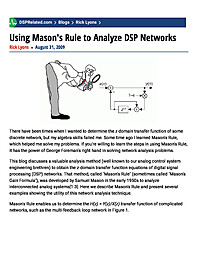
Using Mason's Rule to Analyze DSP Networks
There have been times when I wanted to determine the z-domain transfer function of some discrete network, but my algebra skills failed me. Some time ago I learned Mason's Rule, which helped me solve my problems. If you're willing to learn the...
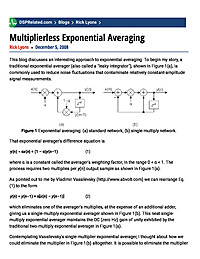
Multiplierless Exponential Averaging
This blog discusses an interesting approach to exponential averaging. To begin my story, a traditional exponential averager (also called a "leaky integrator"), shown in Figure 1(a), is commonly used to reduce noise fluctuations that contaminate...
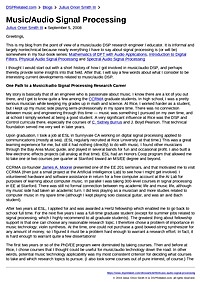
Music/Audio Signal Processing
Greetings,This is my blog from the point of view of a music/audio DSP research engineer / educator. It is informal and largely nontechnical because nearly everything I have to say about signal processing is (or will be) somewhere in my four-book...

PID Without a PhD
I both consult and teach in the area of digital control. Through both of these efforts, I have found that while there certainly are control problems that require all the expertise I can bring to bear, there are a great number of control problems...
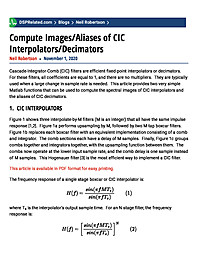
Compute Images/Aliases of CIC Interpolators/Decimators
Cascade-Integrator-Comb (CIC) filters are efficient fixed-point interpolators or decimators. For these filters, all coefficients are equal to 1, and there are no multipliers. They are typically used when a large change in sample...

Make Hardware Great Again
By now you're aware of the collective angst in the US about 5G. Why is the US not a leader in 5G ? Could that also happen -- indeed, is it happening -- in AI ? If we lead in other areas, why not 5G ? What makes it so hard ? This...
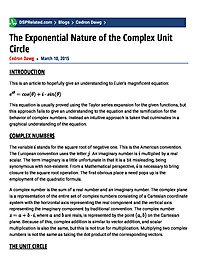
The Exponential Nature of the Complex Unit Circle
Introduction This is an article to hopefully give an understanding to Euler's magnificent equation: $$ e^{i\theta} = cos( \theta ) + i \cdot sin( \theta ) $$ This equation is usually proved using the Taylor series expansion for the given...
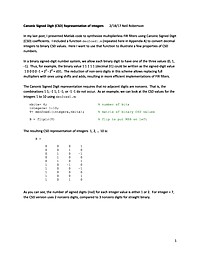
Canonic Signed Digit (CSD) Representation of Integers
In my last post I presented Matlab code to synthesize multiplierless FIR filters using Canonic Signed Digit (CSD) coefficients. I included a function dec2csd1.m (repeated here in Appendix A) to convert decimal integers to binary CSD...
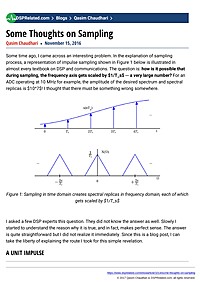
Some Thoughts on Sampling
Some time ago, I came across an interesting problem. In the explanation of sampling process, a representation of impulse sampling shown in Figure 1 below is illustrated in almost every textbook on DSP and communications. The question is: how is...

Blogging Tutorial
This article will be updated on a regular basis based on your questions and feedback. Creating a new blog post Make sure your are logged in Click on 'Create new blog post' Although the online editor works pretty well and...
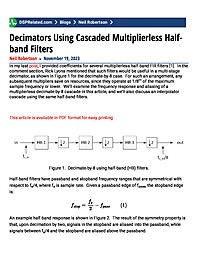
Decimators Using Cascaded Multiplierless Half-band Filters
In my last post, I provided coefficients for several multiplierless half-band FIR filters. In the comment section, Rick Lyons mentioned that such filters would be useful in a multi-stage decimator. For such an application, any subsequent multipliers save on resources, since they operate at a fraction of the maximum sample frequency. We’ll examine the frequency response and aliasing of a multiplierless decimate-by-8 cascade in this article, and we’ll also discuss an interpolator cascade using the same half-band filters.
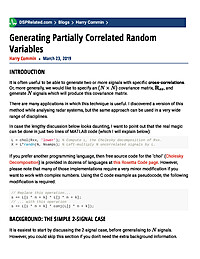
Generating Partially Correlated Random Variables
IntroductionIt is often useful to be able to generate two or more signals with specific cross-correlations. Or, more generally, we would like to specify an $\left(N \times N\right)$ covariance matrix, $\mathbf{R}_{xx}$, and generate $N$ signals...
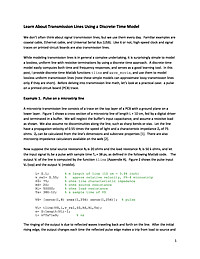
Learn About Transmission Lines Using a Discrete-Time Model
We don’t often think about signal transmission lines, but we use them every day. Familiar examples are coaxial cable, Ethernet cable, and Universal Serial Bus (USB). Like it or not, high-speed clock and signal traces on...


















